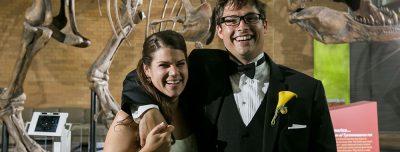April 20, 2017
 As a Lower School student, some of Stephanie Eyerly-Webb’s ’03 favorite MPA moments were watching Upper School kids showcase their annual science contests, such as egg dropping, “flinking,” and building bridges. “This turned me on to science at an early age, and I looked forward to being able to do those projects myself, once I reached Upper School.” Science and math were some of her favorite subjects, and she credits teachers like Mr. Schwieger, Mr. Jensen, Mr. Shapiro, and Ms. Anderson with energizing her with great ideas and classroom projects.
As a Lower School student, some of Stephanie Eyerly-Webb’s ’03 favorite MPA moments were watching Upper School kids showcase their annual science contests, such as egg dropping, “flinking,” and building bridges. “This turned me on to science at an early age, and I looked forward to being able to do those projects myself, once I reached Upper School.” Science and math were some of her favorite subjects, and she credits teachers like Mr. Schwieger, Mr. Jensen, Mr. Shapiro, and Ms. Anderson with energizing her with great ideas and classroom projects.
Beyond academics, Stephanie fondly remembers the Girls Soccer program, coached by Mr. Scinto and Mr. Greimel. It had great impact to be part of “a tight group of girls who accomplished some big goals” that they set for themselves. She remains close friends with many teammates, despite the years and distance from her days at MPA.
After graduating from MPA, Stephanie attended Cornell, drawn by their Veterinary Medicine program. A daughter of two engineers (one at 3M and one at Medtronic, at the time), she majored in Biological and Environmental Engineering and found she loved the problem-solving mindset of being an engineer. Stephanie went on to study Biomedical Engineering at Duke University, obtaining a Masters and Ph.D. She explained, “BME is a very applied engineering field that leans heavily on biology,” which is why it was such a good fit for someone who also loves science. And Duke was perfect, since they not only have a great engineering school, but one of the top medical schools with great hospitals for working with physicians.
Stephanie “caught the research bug” at Duke when she became deeply engaged in an intriguing project. During cardiac ablation procedures, there’s no way to see the heart tissue. Stephanie helped develop an imaging solution, where ultrasound could be used to measure tissue elasticity. This translates into a physician’s ability to virtually “see” ablation lesions. “I was very lucky,” she says, “since I saw the project go from tabletop to animal models and then to first-in-human trials.” As a research scholar, this is a unique occurrence, sealing her commitment to the field of clinical research.
While at Duke, Stephanie met her husband, who was in a Behavioral Science PhD. program. They are both highly career driven, but her research degree made her more versatile—providing there is a major hospital nearby—so they followed Stuart teaching career to the Miami area, which is where they now live.
Stephanie currently works for Memorial Healthcare System, a large community hospital. Her job is to advise doctors of all kinds—pediatricians, cardiologists, trauma physicians, infectious disease specialists—who want to develop their own clinical research. Stephanie, because of her knowledge, experience, innate curiosity, infectious enthusiasm and tenacity, helps doctors set up protocols necessary to move their work forward.
Stephanie’s personal goal is to help improve human health and, specifically, “change at least one thing about how medicine is practiced.” This is a major challenge for any bright health care leader, but if anyone can do it, we have faith that Stephanie can and will.
Today, Stephanie and her husband, Stuart, live in Coral Gables, Florida. They welcomed their first child, Phineas “Phin” James Webb on February 27.